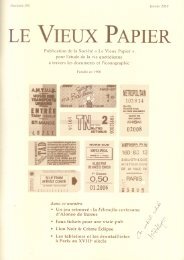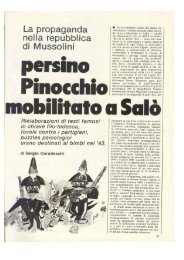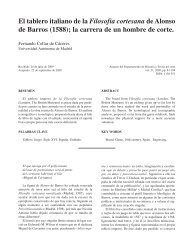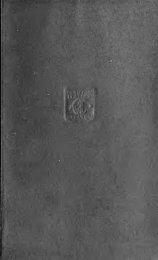Board games from the city of Vijayanagara (Hampi ... - Gioco dell'Oca.
Board games from the city of Vijayanagara (Hampi ... - Gioco dell'Oca.
Board games from the city of Vijayanagara (Hampi ... - Gioco dell'Oca.
You also want an ePaper? Increase the reach of your titles
YUMPU automatically turns print PDFs into web optimized ePapers that Google loves.
On some unusual types <strong>of</strong> stick dice / Peter<br />
Michaelsen<br />
The North European dice board <strong>games</strong> daldøs(a) and sáhkku (described in BGS 4)<br />
are played with some very special dice. These are carved in wood, and are prismatic<br />
and four-sided with more or less pyramidal or rounded ends. They have<br />
four faces which are typically marked with 1, 2, 3, or 4 vertical strokes, which are probably<br />
to be interpreted as <strong>the</strong> corresponding Roman numerals. Sometimes one side is left<br />
blank, and with one exception one <strong>of</strong> <strong>the</strong> sides always is marked with an ‘X’.<br />
Since <strong>the</strong> publication <strong>of</strong> BGS 4, several new pieces <strong>of</strong> information about <strong>the</strong>se <strong>games</strong><br />
and <strong>the</strong>ir dice have come to my knowledge. The close relationship between <strong>the</strong> South-<br />
West Norwegian daldøsa dice and <strong>the</strong> Saami sáhkku dice has become even more evident.<br />
One <strong>of</strong> three types <strong>of</strong> sáhkku dice preserved at Norsk Folkemuseum, Oslo (Fig. 1, c)<br />
is marked in exactly <strong>the</strong> same way as <strong>the</strong> daldøsa dice. Two strokes are placed opposite<br />
to four strokes, and an X opposite to three strokes. This arrangement has not been found<br />
on o<strong>the</strong>r sáhkku dice. The dice mentioned differ in one more respect <strong>from</strong> o<strong>the</strong>r known<br />
sáhkku dice: all edges are chamfered, and in stead <strong>of</strong> a pyramid shape on two sides <strong>the</strong>y<br />
have a square, blank surface, somewhat smaller than <strong>the</strong> four sides provided with symbols.<br />
(1)<br />
The only known pair <strong>of</strong> Danish daldøs<br />
dice belongs to <strong>the</strong> game set kept at Thisted<br />
Museum, North West Jutland. These dice<br />
have short, pyramidal ends, and are marked<br />
with an A instead <strong>of</strong> <strong>the</strong> X found on <strong>the</strong><br />
daldøsa and sáhkku dice. Normally <strong>the</strong><br />
Norwegian daldøsa dice have rounded ends<br />
– a feature found on several 150-200 year<br />
old dice. There are exceptions <strong>from</strong> this<br />
rule, however. Alf Næsheim sent me a drawing<br />
<strong>of</strong> a very old daldøsa die with clearly<br />
pyramidal ends. This unusually large die has<br />
1 cm long ends, making it 6 cm long in<br />
total, and is 3 cm wide. (2)<br />
Fig. 1.Three types <strong>of</strong> sáhkku dice kept<br />
at <strong>the</strong> Norsk Folkemuseum, Oslo.<br />
The 13 dice belonging to type c have<br />
museum no. NFSA.0955, while <strong>the</strong> two<br />
dice <strong>of</strong> type a and one <strong>of</strong> type b<br />
are unnumbered. (Drawing: curator<br />
Leif Pareli, Norsk Folkemuseum).







